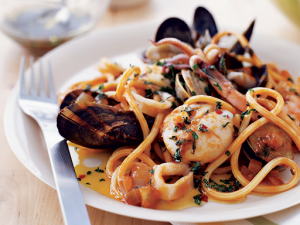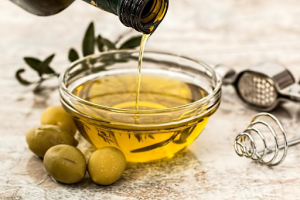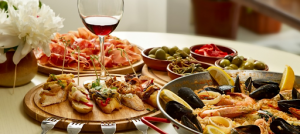The autonomous region of Sardinia stretches over the Italian island of the same name, which is the largest in the country and the second largest in the Mediterranean Sea, located in its very center. It is located about 250 km to the west of the continental part of Italy. Both the climate and nature of Sardinia are unique in general. Sardinia is highly influenced in many aspects by its geographic location, including in terms of the culinary traditions.
The climate is particularly favorable for growing vineyards in the southern part of the island. Among the best local wine varieties in Sardinia are the Cannonau (mostly in the Ogliastra province), Torbato, Monica, Semidano, Vermentino, Moscato and others, which become even better when consumed with local cheeses and meat delicacies.
The unique regional varieties here are protected by the Italian government with a controlled denomination of origin (in Italian – Denominazione di Origine Controllata or DOC). The Vermentino wine from the Gallura province is the only one to which the Italian authorities have given even more special status of a controlled and guaranteed denomination of origin (in Italian – Denominazione di Origine Controllata e Garantita or DOCG).
The cuisine of Sardinia is also historically influenced by the heritage left by the different cultures that have inhabited the lands of the region in the past. The taste of the island dishes can be traced back to the Phoenicians and Greeks, as well as to Arabs, Spaniards and Frenchmen who fought or traded in the region in different periods.
Seafood and Sardinia
Although in the past the main livelihood of the people in the region was rather the shepherd’s craft, not fishery, the seafood still existed in Sardinia, especially in recent years, and also due to the influence of the constant tourist flow.
One of the most famous specialties in Sardinia is Bottarga di muggine. Originally, this dish comes from the small town of Cabras (in Italian – Crabas), which is located on the west coast of Sardinia. The Bottarga is a dried mullet caviar that can be served on thin slices of bread as a starter, or with pasta, for example with spaghetti.
Another great way to start your dinner in Sardinia is by trying the local octopus salad. The octopuses that are caught along the shores of the island are small and much more delicate. They can be garnished with parsley, garlic, lemon and olive oil, and the garniture to them is most often cooked potatoes. Squid with artichoke is another dish that is also typical of the region.
The Catalan lobster is another incredible delicacy from Sardinia that comes from the northwestern part of the island and, in particular, from the Catalan town of Alghero in the Sassari province. Local people here are catching this precious crab on the west coast of the Mediterranean Sea. The lobster is served boiled, then prepared in salad with fresh tomatoes and onions. The most suitable drink for accompaniment to this dish is a glass of white wine, for example Vermentino di Sardegna.
Spaghetti with sea urchin (in Italian – ricci di mare) is another emblematic seafood dish that is present in the culinary tradition in the region of Sardinia. The best period of the year to try this dish is between November and April, and the best wine for it is Cannonau.
It is debatable whether the fish we call sardines are named after the island or not, but they definitely can be found in the waters there, and the sardines from Sardinia are very delicious. But it is also questionable whether they are the emblem of the region, or it is another seafood. Mussels here, for example, are present on the table, perhaps much more frequently, and in all kinds of dishes – in salads, soups, etc. The much more expensive oysters and royal shrimps are also present in the cuisine of the region.
Sardinia is a very large producer of saffron – “zafferano” in Italian
The valuable spice with intense red color is not accidentally called the “red gold” of Sardinia. It has been widely used in the traditional local cuisine for a long time. The plant saffron crocus has an incredible purple color. In November, when the harvest season takes place, the plant paints landscapes in the fields that are unreachable in beauty, exquisiteness and colorfulness.
From the saffron are taken the stigmas and the florets of the plant. It takes a long time for their delicate parts to be collected and dried carefully. The price of the end product is close to that of gold. There is a lot of high quality saffron growing in the region of the second largest city in Sardinia – Sassari.
Fregula/Fregola
Fregola is a type of dried pasta, which is typical of the region of Sardinia, and especially of its capital – Cagliari. This local homemade pasta product is very often perfectly combined with seafood. The Fregola is made from semolina and is shaped as little pearl – something similar to couscous but it has even lighter taste. Perhaps the most delicious dish in Sardinia that contains fregola is a mix of mussels, shrimps and other seafood (according to your taste).
This dish is perfect for the summer season and is served with broth and crispy bread crusts. The special secret spice of the Sardinian fregola, as well as of other popular dishes from the region, is His Majesty the saffron.
Culurgiones
Culurgiones – this Sardinian pasta is similar to the classic ravioli and comes from the Ogliastra province, which is the wildest part of the island. It is unique with its filling of potato cream and enchanting mint aroma. Culurgiones is something like macaroni pockets with size of 5 – 10 cm. they are made from semolina and are usually served with fresh tomato sauce, seasoned with basil, or with butter and aromatic sage.
Another pasta that is traditional for the region is Malloreddus alla Campidanese. For malloreddus can be said that that it is something like the Sardinian gnocchi. Saffron is often use as a spice for this dish.
In fact, some Sardinian recipes still preserve the spirit of Old Europe, where it has long been thought that tomatoes are poisonous and should not be consumed as food. From a modern point of view, it may be difficult to imagine the lack of tomato sauce in the dishes. One of the strangest “substitutes” of tomatoes in the Sardinian cuisine are maybe the walnuts. For this purpose, the nuts were ground and prepared in the form of a sauce with olive oil, garlic, parsley and salt. The recipe is preserved to the present day and can be found in many restaurants in Sardinia.
Large percent of the pecorino cheese that is typical for Italy is produced in Sardinia
This cheese is highly appreciated here and is used in pasta and other appetizers and main dishes, as well as in desserts. The traditional local variety of Sardinian pecorino is called Pecorino Sardo and Pecorino Fiore Sardo. It has a much sharper taste and is typical of the island, as it is rarely found out of it. But the region also exports huge amounts of Pecorino Romano – 97 percent of it is produced here.
The Gallurian region is located in the northern part of the island and extends from Badesi to the town of San Teodoro. Here are the best beaches in Sardinia. Although Gallura is politically part of the Sardinian region, it has its own distinctive dialect, population, as well as unique Italian cuisine and traditions.
Typical for this area, for example, is the dish, which some call “Zuppa Gallurese”, while others call it “Zuppa Guetta” and it is not a soup at all. Although broth is used for its preparation, its consistency is similar to that of lasagna. The Gallurian soup is actually made by placing several bread slices in the oven covered with a mixture of lamb broth and cheese.
Perhaps the most popular Sardinian dish is the so-called „Porcedu“– roast piglet. It should have weight between 4 и 6 kg and is cooked whole with myrtle leaves for a few hours and then is served on a cork tray.
Of course, Sardinia also has its unique sausages produced from the livestock breeding in the region.
For the Easter menu in Sardinia people traditionally prepare lamb with artichoke and most often they consume it with the local Vernaccia wine. The region is a typical shepherd area since many centuries, so it is quite easy to find good quality lamb meat, as well as fresh artichoke, so the freshness of the products is guaranteed. First we have to stew the meat for about an hour, after which the artichoke is added. The combination is incredible and the lamb dish becomes extremely tasty.
One of the traditional Sardinian breads is the pane carasau, also called carta da musica (in literal translation – musical paper). The separate cakes are made from a mixture of white flour and semolina in the form of flat discs, similar to the Arab breads. They are very thin – just like note paper, but the name does not come from there, but from the way they sound when we eat them.
There is also a spicier version of carasau, called the pane guttiau. These cakes contain more salt, as well as oregano. From the pane carasau can be prepared the dish pane frattau, which is a few layers of bread discs, smeared with tomato sauce and cheeses, served with poached eggs.
The pistocu bread is produced mostly in the Ogliastra province and is prepared in a way that is very similar to the method of preparation of pane carasau, but it is thicker and local people prefer to consume it moistened.
In the south and south-east part of the island of Sardinia, the legacy of the Spanish rule has left the so-called panadas – cousins of the Spanish empanadas. Panadas are prepred from semolina and traditionally with lard, although in recent years they can be prepared with olive oil. Due to their shape and size, these cakes were preferred food in the past of the local shepherds and they have become a favorite dish of many local people in Sardinia.
The stuffing can vary depending on the season and the specific area of the island, but most often they are filled with combinations based on lamb meat, chicken or pork meat, traditionally with olives and some vegetable, which can be, for example, zucchini, eggplants, mushrooms, potatoes, peppers or artichoke. Panadas are usually served seasoned with mint, garlic and Pecorino Sardo.
One of the traditional Sardinian desserts is called seadas – in Italian the word is sebadas, but in the Italian dialect the b is silent. This dish is also prepare from semolina and lard and in the past it was a main dish, just like the panadas, but now is consumed mostly as a dessert. Seadas are round fried cakes with a delicate cheese filling – usually a young pecorino with aroma of lemon peels for more freshness. They are served garnished with warm honey or sugar.
Nuts in Sardinia
Sardinia also enjoys an abundance of almonds and other nuts each year. That’s why the island is famous for its splendid desserts with nuts – the delicious almond amaretto, papassini, which can be with walnuts, almonds, raisins and other nuts.
The amaretto is something like our Bulgarian walnut cookies. The name of its Sardinian cousin comes from the Italian word “amaro”, which means “bitter” – because a lot of bitter almonds are used for its preparation. The best almond variety for the preparation of amaretti is the Grappolina almonds, which often can be found in the island.
Another great dessert that you can try in Sardinia is Gatto – cake with caramel and almond glaze, which is served on a lemon tree leaf. Gatto is not an exotic dessert with incredible sweet taste for the local people, but is much more associated with the sweet childhood memories from home.
Tilicas are Sardinian homemade sweets, which most of the local people prepare for Halloween on the 1st of November. They are most common in the northwestern part of Sardinia. Tilicas are prepared with a filling, the ingredients of which may also vary depending on the specific part of the island. Another dessert, which is also typical of the region and is also often prepared for Halloween is the papassini. These are biscuits with glaze, which are traditionally prepared for the family Christmas table.
Apart from almonds, the papassini can be prepared with walnuts, and why not hazelnuts, which are also abundant in Sardinia. Caschettas are something like the Tilicas. However, they are always prepared with walnuts, as well with orange peels and wine.
For the most important occasions, local people prepare masterful sweets called cuoricedus – in the shape of a heart, from where comes their name in Italian. They are always richly decorated and handmade, so this dessert is one of the most masterly performances in the local confectionery tradition.
For the finale of the Sardinian dishes, a Mirto liqueur can be served, which is produced from the blue fruits of the myrtle shrub.


![[:bg]Кухнята на регион Сардиния[:en]Cuisine from the region of Sardinia[:]](https://leonardobansko.com/wp-content/uploads/2019/05/sardinia.jpg)



